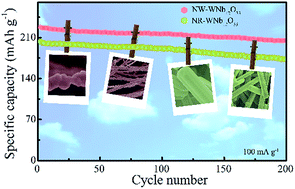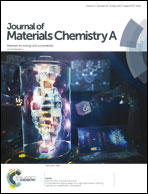Electrospun WNb12O33 nanowires: superior lithium storage capability and their working mechanism†
Abstract
In this study, WNb12O33 with different morphologies were fabricated using various sample collectors through a facile electrospinning method. The WNb12O33 nanorods (NR-WNb12O33) were synthesized using a rounded roller as the sample collector, and the WNb12O33 nanowires (NW-WNb12O33) were prepared using a stainless steel net as a sample collector for the first time. The possible formation process of different morphologies may depend on the self-aggregation of the precursor. Evaluated as a lithium storage anode, NW-WNb12O33 exhibited higher reversible capacity, longer cycle life, and superior rate performance than NR-WNb12O33. Even when cycled at 700 mA g−1, NW-WNb12O33 could retain capacity retention as high as 86.1% after 700 cycles (only 78.9% for NR-WNb12O33). Moreover, the structural change and lithium storage mechanism were studied via in situ X-ray diffraction. It was found that lithium ions insert into the WNb12O33 structure via three steps, and the total volume change is only 1.55%. In addition, in situ observation results also demonstrated that the lithiation/delithiation behavior of NW-WNb12O33 is highly reversible, which makes it a potential candidate for probable high-rate and long-life anode for lithium-ion batteries.

- This article is part of the themed collection: 2017 Journal of Materials Chemistry A HOT Papers


 Please wait while we load your content...
Please wait while we load your content...